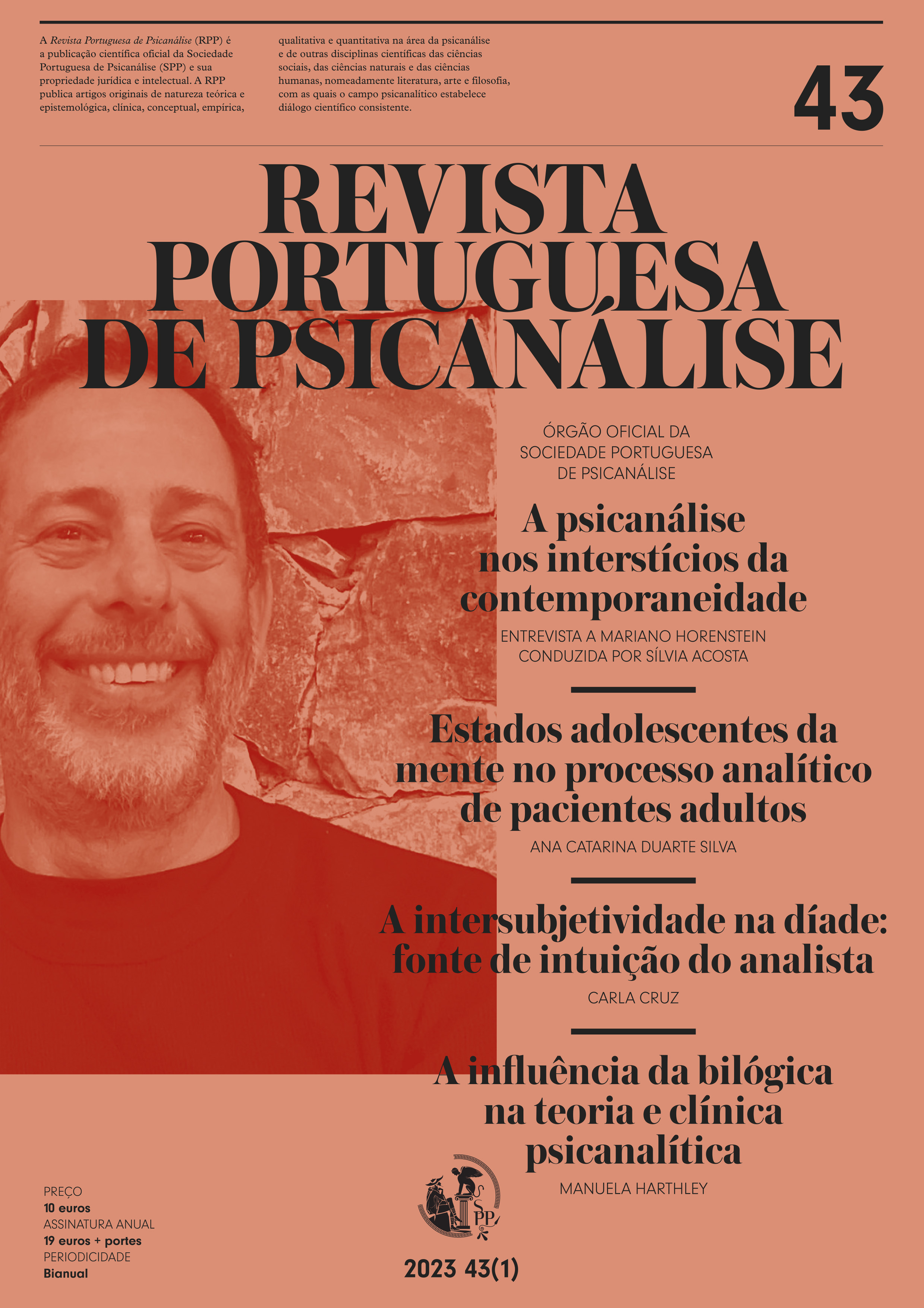Estados adolescentes da mente no processo analítico de pacientes adultos

Abstract
Adolescent states of mind in the analytical process of adult patients
The theme of the existence of an adolescent narrative during the course of an analysis arises from the author’s theoretical and clinical interest in the process of adolescence. The author notes that, at certain moments in the analysis of adults, there is a dispersion of the patient’s sense of identity, resulting in confrontation and opposition within the analytic relationship. There may even be a certain confusion regarding the roles to be played by each person, a dynamic which requires refocusing of the analyst’s posture. Reflecting on these movements, on the dynamic concept of the adolescent process and on the qualities required of the container object throughout the process, the author has thought about the hypothesis of the existence of adolescent states of mind in any analysis of adult patients, requiring from the analyst a specific clinical attitude. She operationalizes this hypothesis based on Astor and Waddell’s ideas on adolescent states of mind as a metapsychology of adolescence, and on the psychoanalytic conceptions of the adolescent process, internal objects, Winnicott’s theories, Field theory and analytic listening theory. Finally, a clinical vignette is presented for demonstration and reflection.
Keywords
Adolescent states of mind, Adolescent process, Adult patients, Adolescent narrative, Listening to listening
Author Biography
Ana Catarina Duarte Silva
Psicóloga Clínica, Psicanalista. Membro Titular da Sociedade Portuguesa de Psicanálise (SPP), da Federação Europeia de Psicanálise (FEP-EFP) e da Associação Psicanalítica Internacional (IPA).
References
- Abram, J. (2012). DWW’s notes for the Vienna Congress 1971, A consideration of Winnicott’s theory of agression and an interpretation of the clinical implications. Em J. Abram (Ed.), Winnicott Today (pp. 303–330). Routledge.
- Abram, J. (2015). L’intégré paternel et son rôle dans la situation analytique. Journal de la psychanalyse de l’enfant, 2(5), 49–68.
- Alexandre, M. F. (2014). A Experiência Psíquica: Ensaio sobre a construção do processo analítico. Fenda.
- Astor, J. (1988). Adolescent States of Mind Found in Patients of Different Ages Seen In Analysis. Journal of Child Psychotherapy, 14(1), 67–80.
- Bion,W. (2014). Learning from Experience. Em C. Mawson (Ed.), The CompleteWorks ofW. R. Bion (vol. iv, pp. 247–365). (Original publicado em 1962.)
- Bion, W. (2014). Elements of Psycho-Analysis. Em C. Mawson (Ed.), The Complete Works of W. R. Bion (vol.v, pp. 1–86). (Original publicado em 1963.)
- Faimberg, H. (2005). The Telescoping of generations. Routledge.
- Faimberg, H. (2019). Basic theoretical assumptions underpinning Faimberg’s method: “Listening to Listening”. The International Journal of Psychoanalysis, 100(3), 447–462.
- Ferro, A. (2006). Psychoanalysis as Therapy and Storytelling, Routledge.
- Ferro, A. (2015). Entrevista a Antonino Ferro por Ana Belchior Melícias. Revista Portuguesa de Psicanálise, 35(2), 113–121.
- Ferro, A. & Nicoli, L. (2017). The New Analist’s Guide to the Galaxy. Karnac Books.
- Freud, S. (1948). Una Teoria Sexual. Em Obras Completas (vol. i, pp.767–818). Editorial Biblioteca Nueva. (Original publicado em 1905.)
- Green, A. (2000). On Thirdness. Em J. Abram (Ed.), André Green at the Squiggle Foundation. Karnac Books.
- Hinshelwood, R. D. (1989). A Dictionary of Kleinian Thought. Free Association Books.
- Klein, M. (1991). Sobre a Identificação. Em Inveja e Gratidão e outros trabalhos (pp. 169–204). Imago. (Original publicado em 1946.)
- Lima, M. C. (2017). Em que sítio da minha cabeça levo a Maria do Carmo? Da génese e destinos da identificação projectiva. Freud & Companhia.
- Meltzer, D. (1990). Sexual States of Mind. Clunie Press. (Original publicado em 1973.)
- Mijolla, A. & Mijolla-Mellor, S. (2002). Psicanálise. Climepsi.
- Penot, B. (2005). Psychoanalytical teamwork in a day hospital: Revisiting some preconditions for patients’ subjective appropriation.The International Journal of Psychoanalysis, 86(2), 503–515.
- Perelberg, R. (Ed.). (2018). Psychic Bissexuality. Routledge.
- Roussillon, R. (2015). An Introduction to theWork on Primary Symbolization. The International Journal of Psychoanalysis, 96(3), 583–594.
- Salgueiro, E. (1987). Breves reflexões sobre o narcisismo e o objecto estético na adolescência. Revista Portuguesa de Psicanálise, 8(1), 71–75.
- Spillius, E. B., Milton, J., Garvey, P., Couve, C. & Steiner, D. (2011). The New Dictionary of Kleinian Thought. Routledge.
- Waddell, M. (2018). On Adolescence. Karnac Books. Winnicott, D. W. (1971). Playing and Reality, Routledge.
- Winnicott, D.W. (1988). Human Nature, Free Association Books.
- Winnicott, D.W. (2011). Communicating and not communicating leading to a study of certain opposites. Em L. Caldwell & A. Joyce (Eds.), Reading Winnicott. Routledge (pp. 182–196). (Original publicado em 1963.)